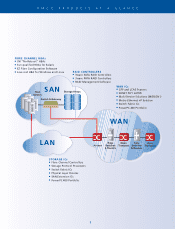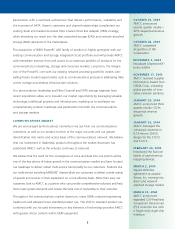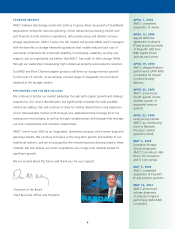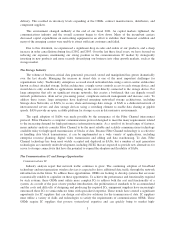3Ware 2004 Annual Report Download - page 10
Download and view the complete annual report
Please find page 10 of the 2004 3Ware annual report below. You can navigate through the pages in the report by either clicking on the pages listed below, or by using the keyword search tool below to find specific information within the annual report.end, on April 1, 2004, we paid approximately $145.0 million in cash to complete this transaction. In addition, on
April 13, 2004, we announced a definitive agreement to acquire intellectual property and a portfolio of assets
associated with IBM’s 400 series of embedded PowerPC®standard products, (the Embedded Processor Business)
for approximately $227.9 million in cash. The PowerPC 400 series product line delivers performance and a rich
mix of features for Internet, communication, data storage, consumer and imaging applications. We plan to
continue evaluating strategic opportunities as they arise, including business combinations, strategic relationships,
capital infusions and the purchase and sale of assets.
Industry Background
The Communications Industry
Communications technology has evolved considerably over the last several years due to the substantial
growth in the Internet and wireless communications. The emergence of new applications, such as wireless web
devices, as well as the increase in demand for higher speed, higher bandwidth and remote network access have
increased network bandwidth requirements.
The increase in volume and complexity of this network traffic has led to the development of new
technologies for use in these networks. These technologies provide substantially greater transmission capacity,
are less error prone and are easier to maintain than copper networks. For example, the Synchronous Optical
Network, or SONET, standard in North America and Japan and the Synchronous Data Hierarchy, or SDH,
standard in the rest of the world became the standards for the transmission of signals over optical fiber. The
SONET/SDH standards facilitate high data integrity and improved network reliability, while reducing
maintenance and other operation costs by standardizing interoperability among equipment from different
vendors. With data and video traffic being added in abundance to voice traffic, Asynchronous Transfer Mode, or
ATM, emerged as a transmission protocol complementary to SONET/SDH to optimize bandwidth utilization.
With exponential increases in data traffic and very modest increases in voice traffic, data has become the
dominant traffic over all networks today. Because of the bandwidth growth and cost pressures in today’s
datacentric networks, more advanced optical networking technologies, such as Dense Wave Division
Multiplexing, or DWDM, have been adopted. DWDM is the optical multiplexing of different wavelengths of
light down a single fiber. Each wavelength is the equivalent of an independent optical channel. DWDM greatly
increases the capacity of installed fiber. Complementing DWDM transmission capabilities are technologies such
as optical Add-Drop Multiplexers, or ADMs, and cross-connects which can more efficiently switch large optical
datapaths through the network. Other protocols, such as multi-protocol level switching, or MPLS, have emerged
that are better suited for data traffic while providing for the low latency and quality of service needs of voice and
video traffic. The SONET/SDH standards have also evolved to more efficiently handle these new protocols with
general framing protocol and virtual concatenation. In addition, emerging technologies such as multi-service
provisionary platforms, or MSPPs, and multi-service switches, or MSSs, allow for the convergence of voice and
data.
The combination of increased traffic and emerging technologies has placed added pressure on the existing
communications network infrastructure and made many systems’ architectures inadequate. In the late 1990’s,
communication service providers and equipment suppliers were affected by the inadequacy of systems’
architectures and began investing in data networks to meet the rapidly growing demands of their customers. In
addition, deregulation of the communications industry and privatization of many European carriers resulted in
increased market competition. The abundance of available capital in the public and private markets accelerated
the build-out of new network infrastructure. Additional telecommunication companies, or carriers were launched
with the goal of capturing significant market share. All of these factors drove a significant increase in capital
spending on networking equipment by both the incumbent and emerging carriers.
During this period of rapid expansion, our customers placed increased orders with us and their other
suppliers to ensure that they had the components needed to fulfill the expected growth in demand for networking
equipment. In retrospect, it appears that OEMs ordered more devices than they needed to secure component
2























